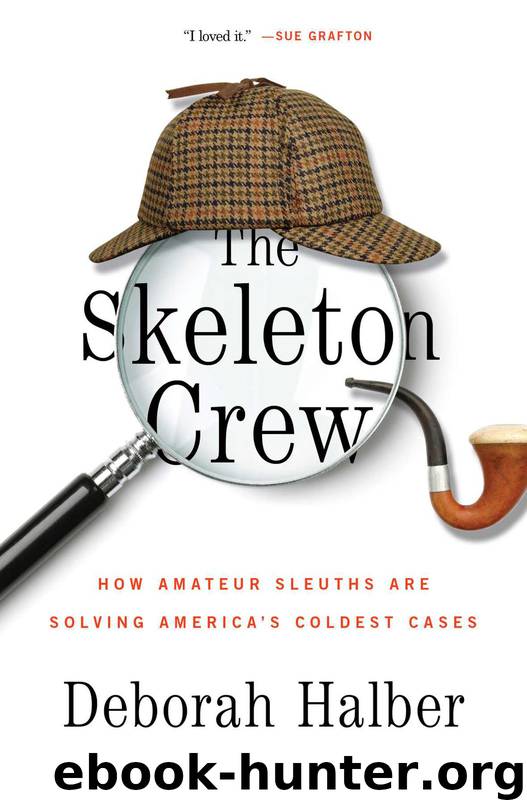The Skeleton Crew: How Amateur Sleuths Are Solving America’s Coldest Cases by Deborah Halber

Author:Deborah Halber [Halber, Deborah]
Language: eng
Format: epub
Publisher: Simon & Schuster
Published: 2014-07-01T00:00:00+00:00
* * *
Old Joe’s remains, mostly skeletonized, were sent to the chief medical examiner’s office at the University of North Carolina in Chapel Hill. “He works on all the bones,” Detective Cheek said. “He puts them back together—or tries to, anyway. I just call and say, ‘Can I speak to Gibbs?’”
I made my way to the tenth floor of a featureless beige building on the campus of the University of North Carolina at Chapel Hill School of Medicine. A man slightly paler than a hospital bedsheet emerged from a back room to greet me. I recognized Clyde Gibbs Jr. from his LinkedIn page, where he’d opted to pose in a black T-shirt emblazoned with a human-size white rib cage, the kind you’d see on a Halloween skeleton costume. “Love anything horror, death, bone, and Doctor Who,” Clyde’s bio reads on Google+.
After decades of anonymity, forensic anthropologists are suddenly rock stars, observed Kathy Reichs, producer of the hit TV series Bones, based on her work as a real-life forensic scientist and her best-selling crime thrillers. Reichs, blond and tousled, could pass for Debbie Harry. Clyde Gibbs would have to be Marilyn Manson.
Gibbs looked like a character from one of his beloved George Romero horror films. For all the hilarity in his social media presence, in person he was low-key and solemn. He wore a small skull cast in metal around his neck. His thinning hair crept back over his prominent forehead; his straggly goatee was shot through with strands of gray; his teeth—what little I could glimpse of them—looked like blackened stubs. The fluorescent light turned his hollow cheeks sallow; he was so rail-thin, he seemed to float like a wraith in a white lab coat through the cinder-block hallways. He exuded an odor of stale cigarette smoke and something sharp and chemical. Formaldehyde? Booze?
I liked Gibbs immediately.
As we sat in a conference room and talked, I pointed a camera at him. He demurely hid his coffee mug in his lap. The mug featured a pale, ghoulish girl in a prim schoolgirl outfit. Long, stringy hair obscured half her face and one of her enormous, black-rimmed, haunted eyes. Not being a fan of the horror genre, I only later recognized the iconic Kyra Schon. She played a little girl turned zombie in Gibbs’s all-time favorite film, Night of the Living Dead, released in 1968, the year Wilbur Riddle stumbled across Tent Girl. In the movie, Schon’s character, Karen Cooper, eats her father’s arm and stabs her mother to death with a trowel.
Gibbs informed me matter-of-factly that his comfort level with the dead stemmed from both his parents working at a funeral home while he was growing up. He didn’t see a human being on the table; he saw a challenge, he offered as an explanation to a question I hadn’t yet asked—a question he apparently heard quite often. “Dealing with the skeletons, it’s a puzzle. You’re going in there saying what’s their age, sex, race, what trauma can I find here?”
Experienced coroners and medical examiners can tell a lot from a corpse.
Download
This site does not store any files on its server. We only index and link to content provided by other sites. Please contact the content providers to delete copyright contents if any and email us, we'll remove relevant links or contents immediately.
The Thirst by Nesbo Jo(6828)
Permanent Record by Edward Snowden(5738)
The Myth of the Strong Leader by Archie Brown(5425)
Spare by Prince Harry The Duke of Sussex(5072)
A Higher Loyalty: Truth, Lies, and Leadership by James Comey(4845)
Secrecy World by Jake Bernstein(4646)
Adulting by Kelly Williams Brown(4487)
The Borden Murders by Sarah Miller(4247)
Machine Learning at Scale with H2O by Gregory Keys | David Whiting(4179)
Killers of the Flower Moon by David Grann(3969)
American Kingpin by Nick Bilton(3757)
Fear by Bob Woodward(3645)
The Secret Barrister by The Secret Barrister(3614)
Future Crimes by Marc Goodman(3533)
The Last Girl by Nadia Murad(3443)
The House on Mango Street by Sandra Cisneros(3396)
Liar's Poker by Michael Lewis(3370)
The Social Psychology of Inequality by Unknown(2940)
Oathbringer (The Stormlight Archive, Book 3) by Brandon Sanderson(2877)
